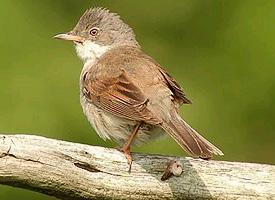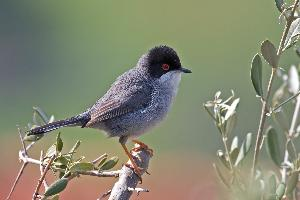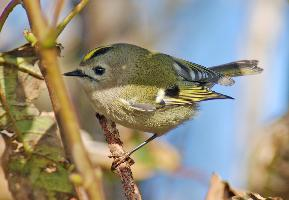
Súlyok és méretek
| Hossz | 13-tól 15-ig cm |
|---|---|
| Súly | 12-tól 17-ig g |
| Szárnyfesztávolság | 19-tól 23-ig cm |
Állatleírás
The Common Whitethroat (Sylvia communis) is a small, charming bird that belongs to the Sylviidae family, widely spread across Europe and the western parts of Asia. It is particularly noted for its distinctive appearance and melodious song, which make it a favorite among birdwatchers and nature enthusiasts.Adult Common Whitethroats typically measure between 13 to 15 centimeters in length, with a wingspan that ranges from 18 to 23 centimeters. They have a relatively light build, weighing between 11 to 18 grams. One of the most striking features of this bird is its plumage. The upper parts are predominantly greyish-brown, which provides excellent camouflage against the dense shrubbery of its habitat. The underparts, however, are a clean, bright white, including the bird's throat, from which it gets its name. The face is adorned with a distinct grey cap and a blackish mask through the eyes, adding to its charismatic appearance. Both sexes display similar coloration, though the males may exhibit slightly brighter hues during the breeding season.
The Common Whitethroat's habitat is quite varied, as these birds are adaptable to a range of environments. They are commonly found in open country with thickets, hedgerows, and shrubs, including farmland, gardens, and the edges of woodlands. Their presence is often heralded by their song, a distinctive, scratchy melody that includes a mix of warbles, trills, and sometimes mimicry of other birds. This vocal performance plays a crucial role during the breeding season, as males sing to establish territories and attract mates.
Diet-wise, the Common Whitethroat is predominantly insectivorous, feeding on a variety of insects and spiders. During the autumn and winter months, their diet shifts to include more berries and fruit, which is crucial for building fat reserves for migration. The bird is a summer visitor to much of its range, migrating to sub-Saharan Africa to spend the winter. This long journey is a testament to its endurance and the global connections within the avian world.
Breeding habits of the Common Whitethroat involve the construction of a cup-shaped nest, which is cleverly concealed in dense shrubbery to protect it from predators. The female lays between 3 to 7 eggs, which she incubates for about two weeks. Once hatched, both parents are involved in feeding the voracious chicks, which fledge approximately two weeks later. This period is a critical time for the young birds, as they must quickly gain strength for the impending migration.
The Common Whitethroat's adaptability to various habitats has helped it maintain stable population levels in many areas, although it, like many migratory birds, faces threats from habitat destruction, climate change, and pollution. Conservation efforts aimed at preserving natural habitats and promoting biodiversity are crucial for ensuring the continued survival of this and other migratory species.
In summary, the Common Whitethroat is a fascinating bird, notable for its distinctive appearance, enchanting song, and remarkable migratory journey. It plays an essential role in the ecosystem, acting as both a predator of insects and a prey species for larger birds. Its presence in a variety of habitats highlights the importance of maintaining diverse and healthy ecosystems for the benefit of all wildlife.
Hasonló állatok
Új állatfotók
Top 10 állat
- Dolphin gull (Leucophaeus scoresbii)
- Japanese macaque (Macaca fuscata)
- Stone loach (Barbatula barbatula)
- Russian tortoise (Testudo horsfieldii)
- Galápagos tortoise (Geochelone nigra complex)
- Greek tortoise (Testudo graeca)
- Diana monkey (Cercopithecus diana)
- Common flying dragon (Draco volans)
- Moustached guenon (Cercopithecus cephus)
- Galápagos penguin (Spheniscus mendiculus)


